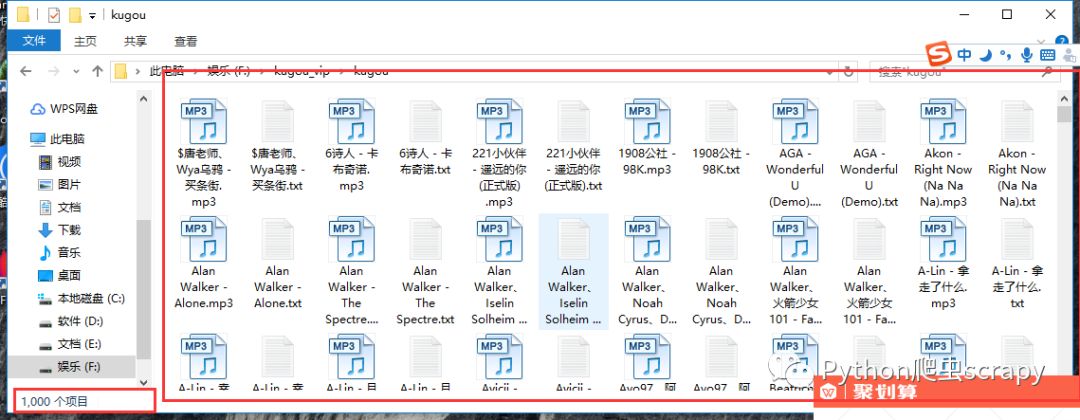溫馨提示×
您好,登錄后才能下訂單哦!
點擊 登錄注冊 即表示同意《億速云用戶服務條款》
您好,登錄后才能下訂單哦!
這篇文章主要介紹“怎么用Python爬取酷狗音樂TOP500”,在日常操作中,相信很多人在怎么用Python爬取酷狗音樂TOP500問題上存在疑惑,小編查閱了各式資料,整理出簡單好用的操作方法,希望對大家解答”怎么用Python爬取酷狗音樂TOP500”的疑惑有所幫助!接下來,請跟著小編一起來學習吧!

上面是網址,

改變數字就可以實現翻頁,所以這個不能翻頁的問題解決了。然后就是老套路按F12查看找network.

往下翻,發現這些都有注釋,那就更好辦了。
解析這個數據,拿出來hash值和filename,歌詞lyric。
也沒什么要說的了,直接貼代碼
import requests
from lxml import etree
import json
import re
import os
class kugou():
def startkugou(self):
for i in range(23, 24):
print(i)
res = requests.get('https://www.kugou.com/yy/rank/home/%s-8888.html?from=rank' % str(i))
self.get_song(res)
def get_song(self, res):
html = etree.HTML(res.content.decode('utf8'))
content = html.xpath('//script[10]')
content2 = content[0].text
# 解析出json列表,類型是str
content1 = content2.split('global.features =')[1].split('(function()')[0].strip()[0:-1]
try:
# 轉換成json數據
content = json.loads(content1)
for i in range(len(content)):
hash = content[i]["Hash"]
file_name = content[i]["FileName"]
hash_url = "http://www.kugou.com/yy/index.php?r=play/getdata&hash=" + hash
hash_content = requests.get(hash_url)
play_url = ''.join(re.findall('"play_url":"(.*?)"', hash_content.text))
lyrics = ''.join(re.findall('"lyrics":"(.*?)"', hash_content.text))
real_download_url = play_url.replace("\\", "")
try:
# if os.path.exists('kugou/' + file_name + '.txt'):
# print(file_name + " 歌詞已經存在")
# # continue
# else:
with open('kugou/' + file_name + '.txt', 'w', encoding='utf8')as f:
f.write(lyrics.encode('utf8').decode('unicode_escape'))
print(file_name + "歌詞已下載完成!")
# if os.path.exists('kugou/' + file_name + '.mp3'):
# print(file_name+" 歌曲已經存在")
# # continue
# else:
with open('kugou/' + file_name + ".mp3", "wb")as fp:
fp.write(requests.get(real_download_url).content)
print(file_name + "歌曲已下載完成!")
except OSError as e:
print("出現異常" + file_name)
file_name = self.validateTitle(file_name)
# if os.path.exists('kugou/' + file_name + '.txt'):
# print(file_name + " 歌詞已經存在")
# # continue
# else:
with open('kugou/' + file_name + '.txt', 'w', encoding='utf8')as f:
f.write(lyrics.encode('utf8').decode('unicode_escape'))
print(file_name + "歌詞已下載完成!")
# if os.path.exists('kugou/' + file_name + '.mp3'):
# print(file_name + " 歌曲已經存在")
# # continue
# else:
with open('kugou/' + file_name + ".mp3", "wb")as fp:
fp.write(requests.get(real_download_url).content)
print(file_name + "歌曲已下載完成!")
except json.decoder.JSONDecodeError as e:
print(e)
print(content2)
content1 = content2.split('global.features =')[1].strip().split('(function() {')[0].strip()
content1 = content1[0:-1]
print(content1)
def validateTitle(self, file_name):
""" 將 title 名字 規則化
:param title: title name 字符串
:return: 文件命名支持的字符串 """
rstr = r"[\=\(\)\,\/\\\:\*\?\"\<\>\|\' ']" # '= ( ) , / \ : * ? " < > | ' 還有空格
new_title = re.sub(rstr, "_", file_name) # 替換為下劃線
return new_title
if __name__ == '__main__':
kugou().startkugou()

到此,關于“怎么用Python爬取酷狗音樂TOP500”的學習就結束了,希望能夠解決大家的疑惑。理論與實踐的搭配能更好的幫助大家學習,快去試試吧!若想繼續學習更多相關知識,請繼續關注億速云網站,小編會繼續努力為大家帶來更多實用的文章!
免責聲明:本站發布的內容(圖片、視頻和文字)以原創、轉載和分享為主,文章觀點不代表本網站立場,如果涉及侵權請聯系站長郵箱:is@yisu.com進行舉報,并提供相關證據,一經查實,將立刻刪除涉嫌侵權內容。